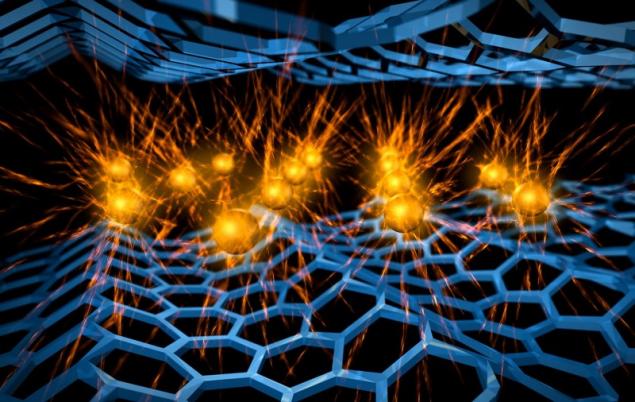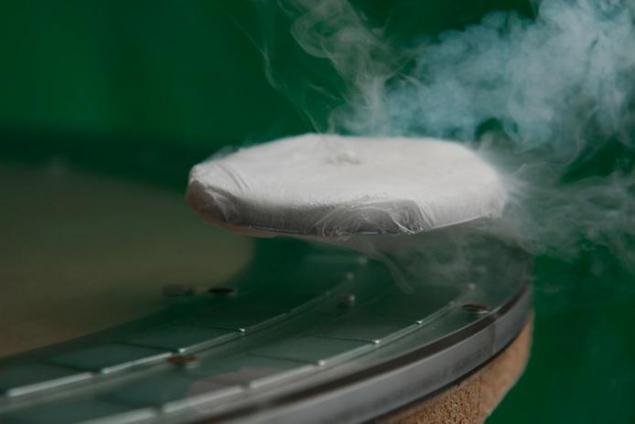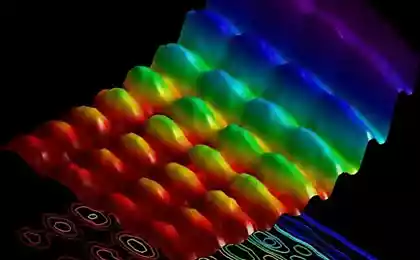613
Created by superconductor operating at earthly temperatures
Physicists have discovered a material that becomes superconducting at a temperature slightly higher than the coldest temperature on Earth. This discovery could mark a new era for the study of superconductivity. The world of superconductivity roared.

Last year, Mikhail Eremets and a couple of his colleagues from the chemistry Institute of max Planck in Mainz, Germany, made an unusual statement about the observation of superconducting hydrogen sulfide at -70 degrees Celsius. This is 20 degrees above any other material, which remains the current record.
The results of the work of scientists began to discuss last December, when they were first posted on arXiv. At that time physics carefully spoke about their work. The history of superconductivity is littered with the corpses of dubious claims about high-temperature activity, which subsequently proved impossible to reproduce.
Since then it's been a while, Eremets and colleagues have worked hard to build the final and convincing evidence. A few weeks ago their work was published in the journal Nature, thus putting a stamp of respectability required in modern physics. Superconductors flickered again in the headlines.
Antonio, Bianconi and Thomas Jarlborg of the Rome international center for materials science in Italy did a review of his exciting field work. And did theoretical work explaining the works of Eremets and his colleagues.
First, a little history. Superconductivity is a phenomenon of zero electrical resistance that occurs in some materials when they are cooled below a critical temperature.
This phenomenon is well known in conventional superconductors, which are essentially rigid lattices of positive ions bathed in a sea of electrons. Electrical resistance occurs because the electrons bump into these lattice and lose energy as it moves through it.
However, at low temperatures the electrons can talk to each other with the formation of Cooper pairs. At the same time, the lattice becomes rigid enough to allow coherent motion of waves called phonons.
The superconductivity arises, when Cooper pairs and phonons traveling through the material, and waves significantly pave the way for electronic vapor. This occurs when the vibration of the grid — its temperature becomes strong enough to break Cooper pairs. This critical temperature.
Until recently, the highest critical temperature of this kind was a mark of -230 degrees Celsius (40 Kelvin).
There are three main characteristics that scientists look for to confirm the superconductivity of the material. The first is a sudden drop of electrical resistance when the material is cooled below the critical temperature. The second is the displacement of the magnetic field from the material, an effect known as the Meissner effect.
The third — changing the critical temperature, when the atoms in the material are replaced by isotopes. This happens because the difference in weight of the isotopes causes the lattice to vibrate differently, which changes the critical temperature.

But there is another type of superconductivity, much less clear. It includes specific ceramic materials discovered in the 1980-ies, which become superconducting at temperatures down to -110 degrees Celsius. Nobody really understands how they work, but most of the research in the superconductivity community focused on these exotic materials.
The eremets and his colleagues, most likely, has changed the balance of items. Perhaps the biggest surprise in their breakthrough is that it does not include "high-temperature" superconductor. It includes the usual hydrogen sulfide, which was never noticed that it was a superconductor at temperatures above 40 degrees Kelvin.
The eremets and his colleagues reached their goal by squeezing the material under pressure, which exists only in the center of the Earth. At the same time, they managed to find evidence of all the most important characteristics of the superconductivity.
And while their experiments are continuing, the theorists scratching their heads trying to explain it. Many physicists believed that there was some theoretical reason why traditional superconductors can work at temperatures above 40 degrees Kelvin. But it turned out that in theory there is nothing that hinders the work of the superconductors at higher temperatures.
In the 1960-ies of the British physicist Neil Ashcroft predicted that hydrogen should be able sverkhprovodniki at high temperatures and pressures, perhaps even at room temperature. His idea was that the hydrogen is so light that should form a lattice that is able to vibrate at very high frequencies and therefore become searchprotocol at high temperatures and pressures.
The eremets and his colleagues seem to confirm this idea. Or at least something like that. There are many theoretical folds that need to be removed before physics will be able to say that we have a correct understanding of what is happening. Theoretical work continues.
Now the race is to search for other superconductors that work at even higher temperatures. One of the promising candidates is H3S (not H2S, which initially worked Eremets).
And, of course, physicists are beginning to think about applications. The use of such materials is very difficult, not only because they are superconductors at high pressures.
But the dream does not interfere with anything. "This discovery is important not only for materials science and condensed matter but also in other fields, from quantum computing to quantum physics of living matter", say Bianconi and Arlberg. They also put forward an interesting idea that this superconductor works at a temperature of 19 degrees above the coldest temperature on Earth.
Perhaps in the coming months and years we will hear a lot about superconductors.published
P. S. And remember, only by changing their consumption — together we change the world! © Join us at Facebook , Vkontakte, Odnoklassniki
Source: hi-news.ru

Last year, Mikhail Eremets and a couple of his colleagues from the chemistry Institute of max Planck in Mainz, Germany, made an unusual statement about the observation of superconducting hydrogen sulfide at -70 degrees Celsius. This is 20 degrees above any other material, which remains the current record.
The results of the work of scientists began to discuss last December, when they were first posted on arXiv. At that time physics carefully spoke about their work. The history of superconductivity is littered with the corpses of dubious claims about high-temperature activity, which subsequently proved impossible to reproduce.
Since then it's been a while, Eremets and colleagues have worked hard to build the final and convincing evidence. A few weeks ago their work was published in the journal Nature, thus putting a stamp of respectability required in modern physics. Superconductors flickered again in the headlines.
Antonio, Bianconi and Thomas Jarlborg of the Rome international center for materials science in Italy did a review of his exciting field work. And did theoretical work explaining the works of Eremets and his colleagues.
First, a little history. Superconductivity is a phenomenon of zero electrical resistance that occurs in some materials when they are cooled below a critical temperature.
This phenomenon is well known in conventional superconductors, which are essentially rigid lattices of positive ions bathed in a sea of electrons. Electrical resistance occurs because the electrons bump into these lattice and lose energy as it moves through it.
However, at low temperatures the electrons can talk to each other with the formation of Cooper pairs. At the same time, the lattice becomes rigid enough to allow coherent motion of waves called phonons.
The superconductivity arises, when Cooper pairs and phonons traveling through the material, and waves significantly pave the way for electronic vapor. This occurs when the vibration of the grid — its temperature becomes strong enough to break Cooper pairs. This critical temperature.
Until recently, the highest critical temperature of this kind was a mark of -230 degrees Celsius (40 Kelvin).
There are three main characteristics that scientists look for to confirm the superconductivity of the material. The first is a sudden drop of electrical resistance when the material is cooled below the critical temperature. The second is the displacement of the magnetic field from the material, an effect known as the Meissner effect.
The third — changing the critical temperature, when the atoms in the material are replaced by isotopes. This happens because the difference in weight of the isotopes causes the lattice to vibrate differently, which changes the critical temperature.

But there is another type of superconductivity, much less clear. It includes specific ceramic materials discovered in the 1980-ies, which become superconducting at temperatures down to -110 degrees Celsius. Nobody really understands how they work, but most of the research in the superconductivity community focused on these exotic materials.
The eremets and his colleagues, most likely, has changed the balance of items. Perhaps the biggest surprise in their breakthrough is that it does not include "high-temperature" superconductor. It includes the usual hydrogen sulfide, which was never noticed that it was a superconductor at temperatures above 40 degrees Kelvin.
The eremets and his colleagues reached their goal by squeezing the material under pressure, which exists only in the center of the Earth. At the same time, they managed to find evidence of all the most important characteristics of the superconductivity.
And while their experiments are continuing, the theorists scratching their heads trying to explain it. Many physicists believed that there was some theoretical reason why traditional superconductors can work at temperatures above 40 degrees Kelvin. But it turned out that in theory there is nothing that hinders the work of the superconductors at higher temperatures.
In the 1960-ies of the British physicist Neil Ashcroft predicted that hydrogen should be able sverkhprovodniki at high temperatures and pressures, perhaps even at room temperature. His idea was that the hydrogen is so light that should form a lattice that is able to vibrate at very high frequencies and therefore become searchprotocol at high temperatures and pressures.
The eremets and his colleagues seem to confirm this idea. Or at least something like that. There are many theoretical folds that need to be removed before physics will be able to say that we have a correct understanding of what is happening. Theoretical work continues.
Now the race is to search for other superconductors that work at even higher temperatures. One of the promising candidates is H3S (not H2S, which initially worked Eremets).
And, of course, physicists are beginning to think about applications. The use of such materials is very difficult, not only because they are superconductors at high pressures.
But the dream does not interfere with anything. "This discovery is important not only for materials science and condensed matter but also in other fields, from quantum computing to quantum physics of living matter", say Bianconi and Arlberg. They also put forward an interesting idea that this superconductor works at a temperature of 19 degrees above the coldest temperature on Earth.
Perhaps in the coming months and years we will hear a lot about superconductors.published
P. S. And remember, only by changing their consumption — together we change the world! © Join us at Facebook , Vkontakte, Odnoklassniki
Source: hi-news.ru























